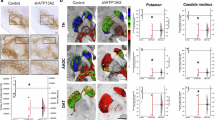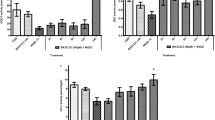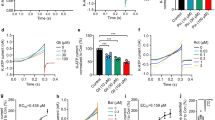Abstract
Aim:
Our preliminary study shows that a bibenzyl compound isolated from Gastrodia elata, 2-[4-hydroxy-3-(4-hydroxybenzyl)benzyl]-4-(4-hydroxybenzyl)phenol (designated 20C), protects PC12 cells against H2O2-induced injury. In this study we investigated whether 20C exerted neuroprotective action in a cell model of Parkinson's disease.
Methods:
A cell model of Parkinson's disease was established in PC12 cells by exposure to rotenone (4 μmol/L) for 48 h. Cell viability and apoptosis were assessed, and intracellular ROS level and the mitochondrial membrane potential (MMP) were detected. The expression of apoptosis-related proteins Bax, Bcl-2, cytochrome c, cleaved caspase-3, and oxidative stress-related proteins Nrf2, HO-1 and NQO1 were examined using Western blotting. The mRNA levels of HO-1 and NQO1 were determined with RT-PCR. The nuclear translocation of Nrf2 was observed with immunofluorescence staining.
Results:
Treatment with rotenone significantly increased the number of apoptotic cells, accompanied by marked increases in the Bax/Bcl-2 ratio, cytochrome c release and caspase-3 activation. Rotenone also increased ROS accumulation, reduced MMP, and increased the nuclear translocation of Nrf2 as well as the mRNA and protein levels of the Nrf2 downstream target genes HO-1 and NQO1 in PC12 cells. Co-treatment with 20C (0.01–1 μmol/L) dose-dependently attenuated rotenone-induced apoptosis and oxidative stress in PC12 cells. Nrf2 knockdown by siRNA partially reversed the protective effects of 20C in rotenone-treated PC12 cells.
Conclusion:
The bibenzyl compound 20C protects PC12 cells from rotenone-induced apoptosis, at least in part, via activation of the Nrf2/ARE/HO-1 signaling pathway.
Similar content being viewed by others
Log in or create a free account to read this content
Gain free access to this article, as well as selected content from this journal and more on nature.com
or
References
Dauer W, Przedborski S . Parkinson's Disease: mechanisms and models. Neuron 2003; 39: 889–909.
Ozansoy M, Basak AN . The central theme of Parkinson's disease: alpha-synuclein. Mol Neurobiol 2013; 47: 460–5.
Schapira AH . Mitochondria in the etiology and pathogenesis of Parkinson's disease. Lancet Neurol 2008; 7: 97–109.
Trushina E, Mcmurray CT . Oxidative stress and mitochondrial dysfunction in neurodegenerative diseases. Neuroscience 2007; 145: 1233–48.
Perier C, Bove J, Vila M, Przedborski S . The rotenone model of Parkinson's disease. Trends Neurosci 2003; 26: 345–6.
Li N, Ragheb KE, Lawler G, Sturgis J, Rajwa B, Melendez JA, et al. Mitochondrial complex I inhibitor rotenone induces apoptosis through enhancing mitochondrial reactive oxygen species production. J Biol Chem 2003; 278: 8516–25.
Girish C, Muralidhara . Propensity of Selaginella delicatula aqueous extract to offset rotenone-induced oxidative dysfunctions and neurotoxicity in Drosophila mela-nogaster: implications for Parkinson's disease. Neurotoxicology 2012; 33: 444–56.
Ojemann LM, Nelson WL, Shin DS, Rowe AO, Buchanan RA . Tian ma, an ancient Chinese herb, offers new options for the treatment of epilepsy and other conditions. Epilepsy Behav 2006; 8: 376–83.
Shin EJ, Bach JH, Nguyen TT, Nguyen XK, Jung BD, Oh KW, et al. Gastrodia elata bl attenuates methamphetamine-induced dopaminergic toxicity via inhibiting oxidative burdens. Curr Neuropharmacol. 2011; 9: 118–21.
Liu J, Mori A . Antioxidant and free radical scavenging activities of Gastrodia elata Bl. and Uncaria rhynchophylla (Miq.) Jacks. Neuropharmacology 1992; 31: 1287–98.
Kobayashi M, Yamamoto M . Nrf2–Keap1 regulation of cellular defense mechanisms against electrophiles and reactive oxygen species. Adv Enzyme Regul 2006; 46: 113–40.
Kobayashi A, Kang MI, Okawa H, Ohtsuji M, Zenke Y, Chiba T, et al. Oxidative stress sensor Keap1 functions as an adaptor for Cul3-based E3 ligase to regulate proteasomal degradation of Nrf2. Mol Cell Biol 2004; 24: 7130–9.
De Vries HE, Witte M, Hondius D, Rozemuller AJ, Drukarch B, Hoozemans J, et al. Nrf2-induced antioxidant protection: a promising target to counteract ROS-mediated damage in neurodegenerative disease? Free Radic Biol Med 2008; 45: 1375–83.
Cho HY, Reddy SP, Debiase A, Yamamoto M, Kleeberger SR . Gene expression profiling of NRF2-mediated protection against oxidative injury. Free Radic Biol Med 2005; 38: 325–43.
Barone MC, Sykiotis GP, Bohmann D . Genetic activation of Nrf2 signaling is sufficient to ameliorate neurodegenerative phenotypes in a Drosophila model of Parkinson's disease. Dis Model Mech 2011; 4: 701–7.
Tufekci KU, Civi Bayin E, Genc S, Genc K . The Nrf2/ARE pathway: a promising target to counteract mitochondrial dysfunction in Parkinson's disease. Parkinsons Dis 2011; 314082.
Nicoletti I, Migliorati G, Pagliacci MC, Grignani F, Riccardi C . A rapid and simple method for measuring thymocyte apoptosis by propidium iodide staining and flow cytometry. J Immunol Methods 1991; 139: 271–9.
Song XY, Hu JF, Chu SF, Li ZP, Wu DH, Ji HJ, et al. IMM-H004, a novel coumarin derivative compound, protects against amyloid beta-induced neurotoxicity through a mitochondrial-dependent pathway. Neuroscience 2013; 242: 28–38.
Lin MT, Beal MF . Mitochondrial dysfunction and oxidative stress in neurodegenerative diseases. Nature 2006; 443: 787–95.
Betarbet R, Sherer TB, MacKenzie G, Garcia-Osuna M, Panov AV, Greenamyre JT . Chronic systemic pesticide exposure reproduces features of Parkinson's disease. Nat Neurosci 2000; 3: 1301–6.
Scapagnini G, Vasto S, Abraham NG, Caruso C, Zella D, Fabio G . Modulation of Nrf2/ARE pathway by food polyphenols: a nutritional neuroprotective strategy for cognitive and neurodegenerative disorders. Mol Neurobiol 2011; 44: 192–201.
Greene LA, Tischler AS . Establishment of a noradrenergic clonal line of rat adrenal pheochromocytoma cells which respond to nerve growth factor. Proc Natl Acad Sci U S A 1976; 73: 2424–8.
Li BY, Yuan YH, Hu JF, Zhao Q, Zhang DM, Chen NH . Protective effect of Bu-7, a flavonoid extracted from Clausena lansium, against rotenone injury in PC12 cells. Acta Pharmacol Sin 2011; 32: 1321–6.
Pei W, Liou AK, Chen J . Two caspase-mediated apoptotic pathways induced by rotenone toxicity in cortical neuronal cells. FASEB J 2003; 17: 520–2.
Tan S, Sagara Y, Liu Y, Maher P, Schubert D . The regulation of reactive oxygen species production during programmed cell death. J Cell Biol 1998; 141: 1423–32.
Kim WH, Park WB, Gao B, Jung MH . Critical role of reactive oxygen species and mitochondrial membrane potential in Korean mistletoe lectin-induced apoptosis in human hepatocarcinoma cells. Mol Pharmacol 2004; 66: 1383–96.
Velichkova M, Hasson T . Keap1 regulates the oxidation-sensitive shuttling of Nrf2 into and out of the nucleus via a Crm1-dependent nuclear export mechanism. Mol Cell Biol 2005; 25: 4501–13.
Wakabayashi N, Dinkova-Kostova AT, Holtzclaw WD, Kang MI, Kobayashi A, Yamamoto M, et al. Protection against electrophile and oxidant stress by induction of the phase 2 response: fate of cysteines of the Keap1 sensor modified by inducers. Proc Natl Acad Sci U S A 2004; 101: 2040–5.
Suttner DM, Dennery PA . Reversal of HO-1 related cytoprotection with increased expression is due to reactive iron. FASEB J 1999; 13: 1800–9.
Quesada A, Ogi J, Schultz J, Handforth A . C-terminal mechano-growth factor induces heme oxygenase-1-mediated neuroprotection of SH-SY5Y cells via the protein kinase C/Nrf2 pathway. J Neurosci Res 2011; 89: 394–405.
Ross D, Kepa JK, Winski SL, Beall HD, Anwar A, Siegel D . NAD(P)H:quinone oxidoreductase 1 (NQO1): chemoprotection, bioactivation, gene regulation and genetic polymorphisms. Chem Biol Interact 2000; 129: 77–97.
Lin HY, Yeh WL, Huang BR, Lin C, Lai CH, Lin H, et al. Desipramine protects neuronal cell death and induces heme oxygenase-1 expression in Mes23.5 dopaminergic neurons. PLoS One 2012; 7: e 50138.
Mineli A, Conte C, Grottelli S, Bellezza M, Cacciatore I, Bolanos JP . Cyclo(His-Pro) promotes cytoprotection by activating Nrf2-mediated up-regulation of antioxidant defence. J Cell Mol Med 2009; 13: 1149–61.
Jiang G, Hu Y, Liu L, Cai J, Peng C, Li Q . Gastrodin protects against MPP(+)-induced oxidative stress by up regulates heme oxygenase-1 expression through p38 MAPK/Nrf2 pathway in human dopaminergic cells. Neurochem Int 2014; 75: 79–88.
Johnson JA, Johnson DA, Kraft AD, Calkins MJ, Jakel RJ, Vargas MR, et al. The NRF2/ARE pathway: an indicator and modulator of oxidative stress in neurodegeneration. Ann N Y Acad Sci 2008; 1147: 61–9.
Ye S, Chen M, Jiang Y, Chen M, Zhou T, Wang Y, et al. Polyhydroxylated fullerene attenuates oxidative stress-induced apoptosis via a fortifying Nrf2-regulated cellular antioxidant defence system. Int J Nanomedicine 2014; 9: 2073–87.
Acknowledgements
This work was supported by the National Natural Science Foundation of China (No 81274122, No 81102831, and No 81273629), the National Key Sci-Tech Major Special Item (No 2012ZX09301002-004 and No 2012ZX09103101-006), the National High-Tech R&D Programme (863 Program) (No 2012AA020303), the Program for Changjiang Scholars and Innovative Research Team in University (PCSIRT) (No IRT1007), the Specialized Research Fund for the Doctoral Program of Higher Education of China (No 20121106130001), Beijing Natural Science Foundation (No 7131013 and No 7142115), Beijing Key Laboratory of New Drug Mechanisms and Pharmacological Evaluation Study (No BZ0150).
Author information
Authors and Affiliations
Corresponding author
Rights and permissions
About this article
Cite this article
Huang, Jy., Yuan, Yh., Yan, Jq. et al. 20C, a bibenzyl compound isolated from Gastrodia elata, protects PC12 cells against rotenone-induced apoptosis via activation of the Nrf2/ARE/HO-1 signaling pathway. Acta Pharmacol Sin 37, 731–740 (2016). https://doi.org/10.1038/aps.2015.154
Received:
Accepted:
Published:
Issue date:
DOI: https://doi.org/10.1038/aps.2015.154
Keywords
This article is cited by
-
Hsa_circ_0096157 silencing suppresses autophagy and reduces cisplatin resistance in non-small cell lung cancer by weakening the Nrf2/ARE signaling pathway
Molecular Biology Reports (2024)
-
A small molecule 20C from Gastrodia elata inhibits α-synuclein aggregation and prevents progression of Parkinson’s disease
Cell Death & Disease (2023)
-
Neuroprotective actions of a fatty acid nitroalkene in Parkinson’s disease
npj Parkinson's Disease (2023)
-
Berberine Alleviates the Damage, Oxidative Stress and Mitochondrial Dysfunction of PC12 Cells Induced by High Glucose by Activating the KEAP1/Nrf2/ARE Pathway
Molecular Biotechnology (2023)
-
Delivery of the reduced form of vitamin K2(20) to NIH/3T3 cells partially protects against rotenone induced cell death
Scientific Reports (2022)



